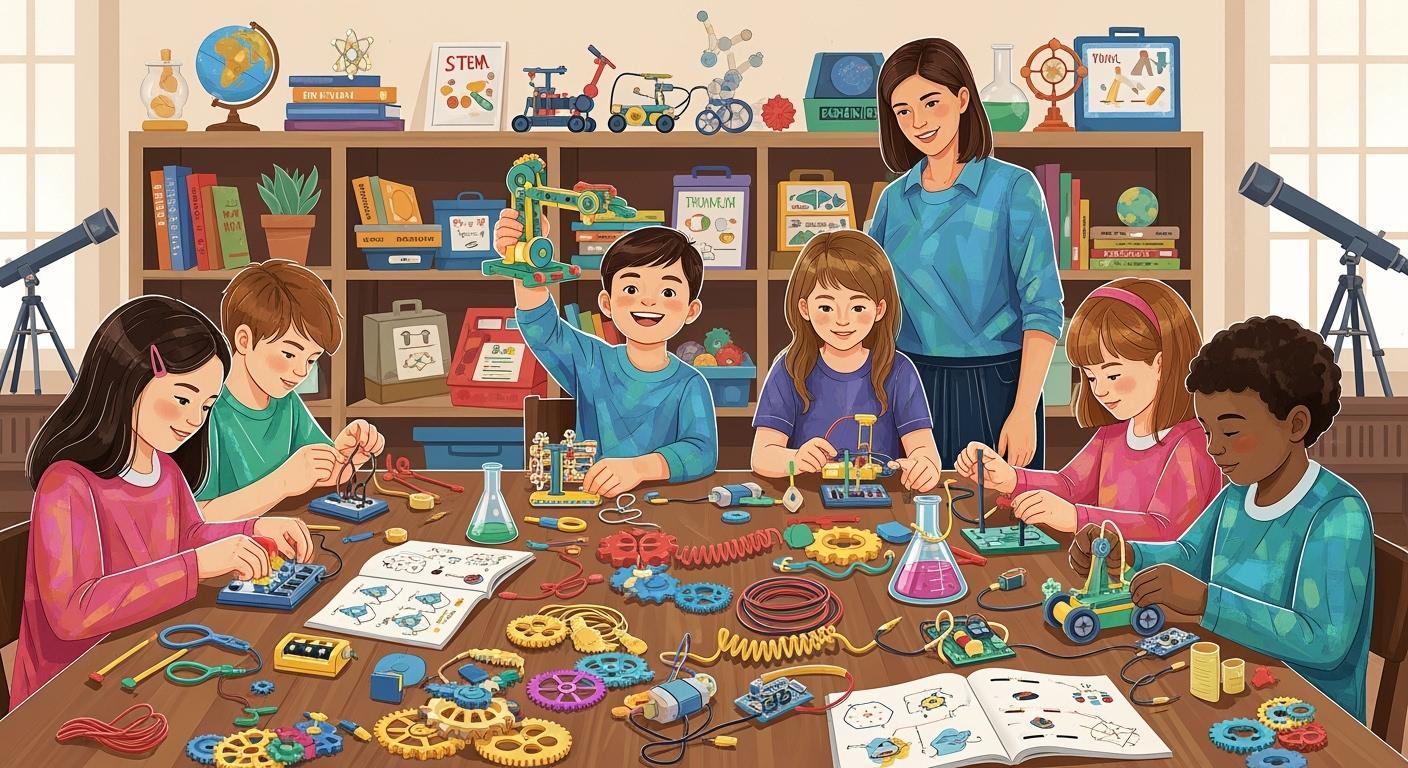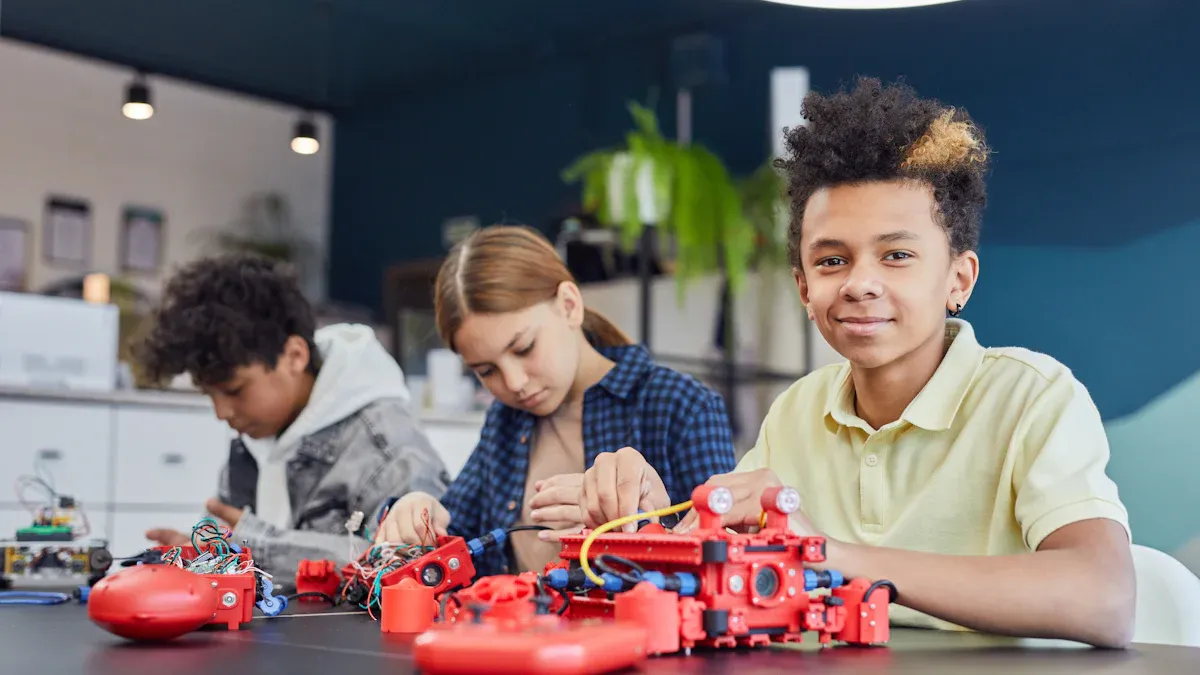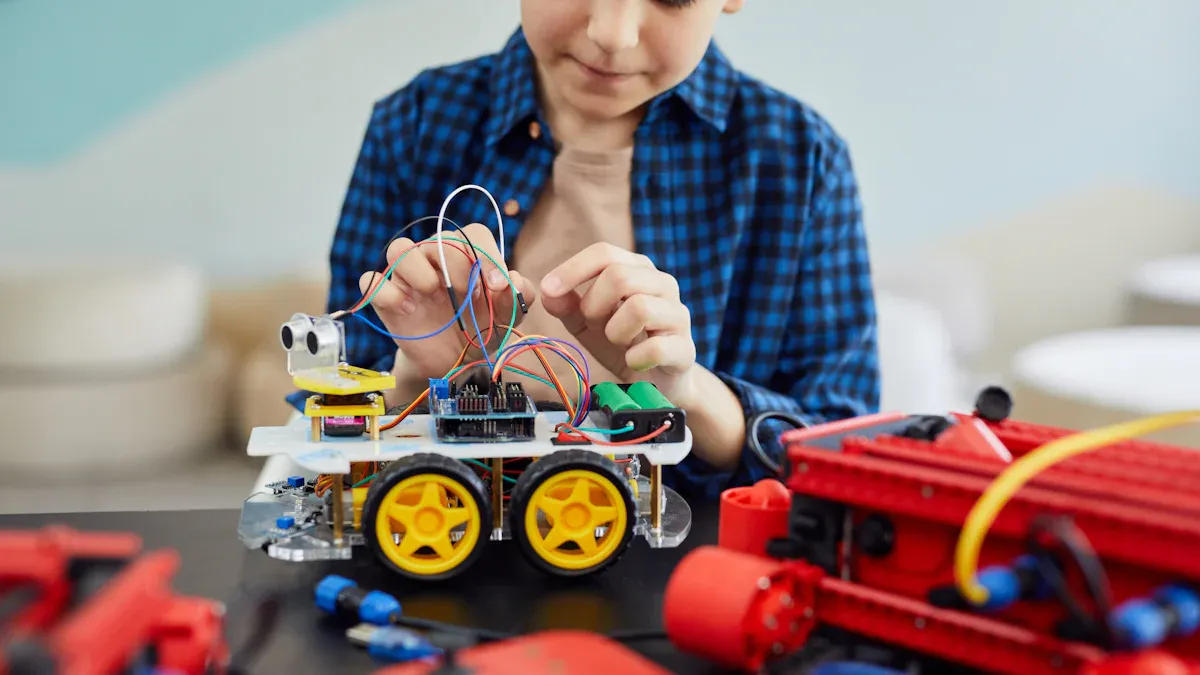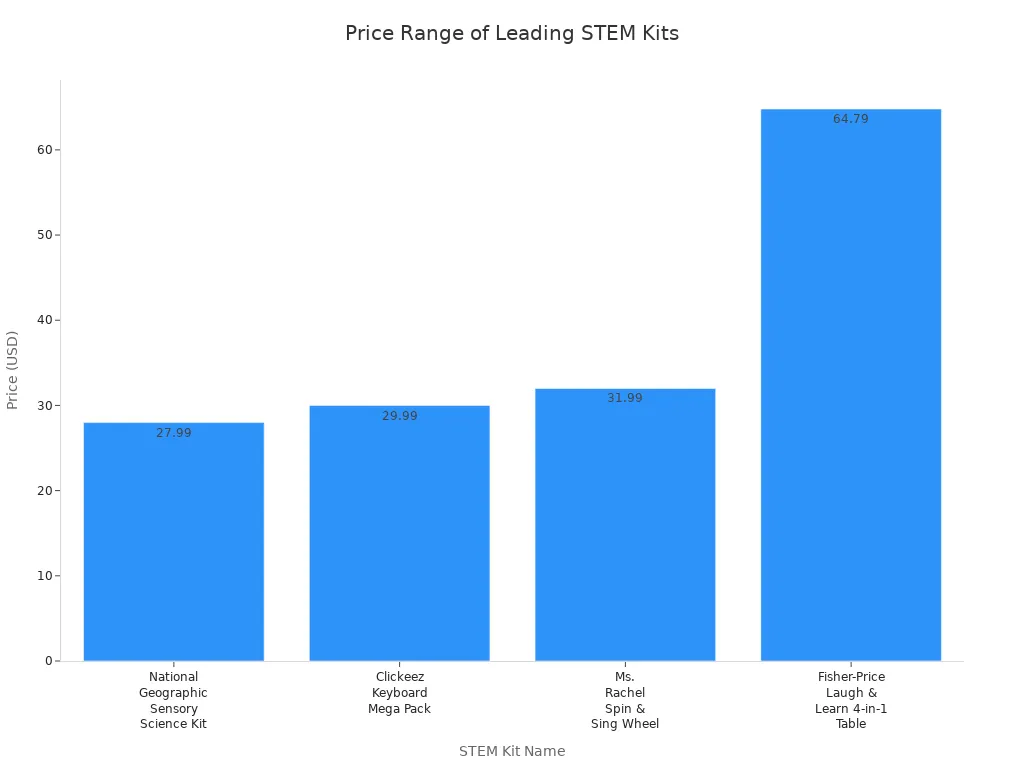Top Affordable STEM Kits for Elementary Students in 2025

Are you searching for the best stem kits for elementary students in 2025? Check out these excellent stem kits for elementary learners:
Product Name | Price | Standout Features |
|---|---|---|
Excellerations® STEM Magnetic Builders - 130 Pieces | $219.99 | This magnetic stem kit for elementary kids sparks creativity. |
Excellerations® Masonry Foam Floor Blocks - Set of 20 | $184.99 | Soft foam blocks make this stem kit for elementary students safe and easy to use. |
Excellerations® Foam Floor Building Pavers - Set of 30 | $184.99 | These pavers are a versatile stem kit for elementary classrooms. |
Hands-on stem kits for elementary students like these inspire curiosity and build confidence. With each project, you can help children learn, solve problems, and enjoy the benefits of stem kits for elementary education.
Key Takeaways
Pick STEM kits that fit your child's age and interests. This helps them learn better.
Doing STEM activities with your hands helps kids be creative. It also helps them solve problems and work together.
Cheap DIY STEM projects at home can make kids curious. These projects make learning fun and do not cost a lot.
Best STEM Kits for Elementary Students

Quick Comparison Table
You want to pick a good kit for your child. Here is a table with some top stem kits for elementary students in 2025:
Kit Name | Price | Age Range | Key Features |
|---|---|---|---|
KiwiCo STEM Kits | $24.95+/month | 5-11 | Monthly projects, hands-on builds, creative challenges |
Mel Science Kits | $34.90/month | 5-14 | Real science experiments, VR lessons, safe materials |
National Geographic Kits | $29.99+ | 6-12 | Fossil digs, crystal growing, earth science focus |
Steve Spangler Science Kits | $24.99+/month | 5-12 | Exciting experiments, easy instructions, family-friendly |
STEM Bins Essential Kit | $39.99 | 5-10 | Open-ended building, reusable parts, classroom or home use |
STEM Discovery Boxes | $29.95/month | 7-12 | Themed activities, engineering and coding, all-in-one kits |
Electric Circuit Kit | $19.99+ | 8-12 | Snap-together circuits, lights and sounds, safe for beginners |
Key Features Overview
When you choose stem kits for elementary students, you want more than just fun. You want your child to learn by doing things. The best kits let kids use their hands and try new ideas. These kits help kids get curious and solve problems. They also fit your child’s age and are safe to use. For example, KiwiCo and Mel Science have monthly projects. These keep kids interested in learning new things. National Geographic kits let kids dig for fossils or grow crystals. This makes science feel like a real adventure.
Many parents want their kids to try stem education, but not everyone wants to spend a lot of money. You can find stem kits for elementary students that are not too expensive and still work well. Most kits now have real experiments and open-ended play. They also have easy instructions. Many kits use safe, non-toxic materials and do not have small parts. This helps you feel better while your child learns and explores.
Tip: Pick stem toys that help your child ask questions and try new things. The best kits make learning fun and playful!
Why Choose STEM Toys for Kids
Benefits of STEM Toys
You want your child to have fun while learning. STEM toys help kids learn important skills for the future. Playing with these toys helps kids grow and learn new things. If you start stem education early, your child learns to solve problems. They also learn to think carefully and talk about ideas. Studies show kids who learn STEM before age eight do better in school. They also get better at using language.
Here’s what your child gets from STEM toys:
Creativity
Working with others
Confidence
Using skills in real life
When kids play with puzzles and do experiments, they think in new ways. You see them use memory and spatial reasoning. These toys help kids be creative and work as a team. Kids learn more when they do hands-on activities together.
Tip: Let your child try different stem toys. You will see their confidence grow as they finish new challenges.
Encouraging Hands-On Learning
Hands-on learning makes science and math fun. When kids do experiments, they guess what will happen. They test their ideas and learn from results. This helps kids get curious and learn how science works. You can use stem toys with stories to make learning even better.
Hands-on learning helps kids ask questions and think deeply.
Kids solve problems and work together during activities.
These toys help kids use their hands and think about space.
STEM toys teach useful skills and show how play connects to jobs.
Kids remember ideas better when they use stem toys every day. Asking open-ended questions helps kids think more about balance and stability. With many experiments, learning feels easy and fun.
Top Science Kits Reviewed
KiwiCo STEM Kits
KiwiCo STEM Kits make learning fun and playful. Each box has hands-on activities for you. You get tools like a stethoscope and toy syringe. There are animal cards and a light-box too. These kits let you learn about animal anatomy. You can pretend to be a vet and explore STEM jobs. Every project meets science and math standards. The price is $29.95, so it is a good deal. Kids enjoy the creative tasks and use their imagination.
Tip: KiwiCo STEM Kits help you do real science at home. You can watch your child learn new things and feel proud.
Mel Science Kits
Mel Science Kits turn your table into a science lab. You get real experiments with safe materials. Every month, you get new projects to try. The kits cover chemistry, physics, and more topics. You can use VR lessons to see science happen. Kids ages 5 to 14 can use these kits. The instructions are easy to follow. You do not need to buy extra supplies. Mel Science Kits help you learn how things work. Your child will ask more questions and get excited.
National Geographic Science Kits
National Geographic science kits bring adventure to your home. You can paint a solar system or launch a foam rocket. You can also make a night sky with glowing stars. The kits have paint, magnets, and constellation cards. You learn about planets and constellations. You also learn about chemical reactions. The activities make space and science fun. Kids enjoy the hands-on projects and love to explore.
Paint and show 3D models of planets and the Sun.
Launch a foam rocket and learn about reactions.
Make a glowing night sky and find constellations.
Steve Spangler Science Kits
Steve Spangler science kits make science simple for everyone. You get fun lessons with no prep needed. Parents and teachers like these kits a lot. You do not need to buy extra supplies. Each kit has 40 STEM Starter lessons for all grades. You can use them in class or at home. The lessons follow science and engineering rules. Kids learn to think and solve problems. You get a year of science content, so learning keeps going.
Note: Steve Spangler science kits are great for busy families. You can start learning right away with no waiting.
STEM Bins Essential Kit
STEM Bins Essential Kit gives you all you need to build. The kit has many materials to spark your ideas. You can build, design, and solve problems your way. The activities help you think and work with others. Teachers use these kits to help teamwork in class. At home, you can play and build anything you want. The kit works for different learning styles. Every child can find something they like.
Feature/Benefit | Description |
|---|---|
Fosters Creativity | Helps you think in new ways and be creative |
Enhances Critical Thinking | Makes you solve problems and think hard |
Promotes Collaboration | Lets you work with friends and classmates |
Engaging Learning Experience | Keeps you interested and having fun |
Supports Diverse Learning Styles | Has many materials for all kinds of learners |
STEM Discovery Boxes
STEM Discovery Boxes are special for their variety and depth. Each month, you get three new projects to try. The topics include electronics, chemistry, physics, and coding. You might build a draw-bot or a solar-powered fan. You can also learn about the heart and blood vessels. These kits have won awards and are good for families. Kids ages 7 to 12 can enjoy hands-on learning. The activities help you learn about real science and engineering.
Project/Activity | Topics Covered |
|---|---|
Chemistry, Physics, Electronics | Hands-on projects sent every month |
Circulatory System | Learn about the heart and blood vessels |
Draw-Bot | Build a robot that draws pictures |
Solar-Powered Fan | Learn about energy from the sun |
Locking Safe | Try math and mechanical engineering |
Electric Dough | Make circuits using dough |
Parents like STEM Discovery Boxes because they are fun for families.
Electric Circuit Kit
Electric Circuit Kits help you learn about electricity safely. You can snap pieces together to make circuits. Kits like HamiltonBuhl Electronic Blocks and Snap Circuits Jr. teach you to read diagrams. You learn about resistance and how circuits work. You see lights flash and hear sounds when you finish. These kits help you solve problems and learn about technology. Teachers like them because they have free lesson plans. The kits teach the basics of electricity and magnetism.
Build circuits with 30 easy pieces.
Learn how electricity moves and fix problems.
Finish projects fast and stay interested.
If you want to be curious and learn by doing, try these science kits. You can find a kit you like and build new skills.
Affordable STEM Activities at Home
DIY STEM Projects
You do not need special supplies for science at home. You can use things you already have for diy stem activities. Try making a marble roller coaster from cardboard tubes. You can also launch a paper rocket outside. These projects let you learn about physics and engineering. You can be creative and save money at the same time.
Here is a table with fun projects you can try now:
Project Name | Description |
|---|---|
Marble Roller Coaster | Use old tubes to build and learn about movement. |
Balloon-Powered Car | Make a car with cardboard and bottle caps. Use a balloon to make it go. |
Water Filtration Experiment | Build a water filter with easy supplies. See how filtration works. |
DIY Catapult Challenge | Use LEGO or marshmallows to make and test catapults. |
Rain Gauge | Measure rain with a plastic bottle. |
Wind Power Experiments | Make a windmill or wind vane to learn about wind energy. |
You can find free online guides for affordable stem activities. Try Khan Academy for practice, Legends of Learning for games, or LabXchange for labs. These websites make learning simple and fun.
Resource Name | Description |
|---|---|
Khan Academy | Practice and watch videos for many subjects. |
Legends of Learning | Play math and science games for kids. |
LabXchange | Try online labs and science activities. |
BrainPOP | Watch animated videos and take quizzes for science and engineering. |
DiscoverE | Do hands-on activities to learn about engineering. |
Tip: Try tech-free coding, build with Legos, or make music with Chrome Music Lab. These ideas keep learning fun and hands-on.
Everyday Materials for Learning
You can teach science with things you find at home. Try a water cycle experiment with a ziplock bag and water. Watch how the sun makes water evaporate and form drops. Make a light-up card with copper tape, an LED, and a battery. You will learn about circuits and get creative too.
Here are more ways to use everyday things for learning:
Build a marble run with cardboard and tape. See how gravity and speed work.
Make a bug hotel from sticks and leaves. Study bugs and learn about nature.
Create a pinhole camera to watch an eclipse. Find out how light moves.
Affordable stem activities help you use what you have and get curious. You do not need to buy expensive stem toys to learn science. Just look around, grab some supplies, and start your own experiments.
How to Choose the Right STEM Kit
Matching Kits to Interests and Age
You want your child to love learning, so picking the right STEM kit matters. Start by thinking about what your child enjoys. Some kids like building, while others love experiments or exploring nature. Match the kit to your child’s interests and age for the best experience.
Always check the age range on the box. This helps you find kits with safe parts and the right challenge.
Look for kits made from strong, safe materials. You want something that lasts and keeps your child safe.
Choose kits that support different learning styles. Some kits work well for kids with Autism or ADHD.
Pick kits that spark curiosity and let your child explore hands-on.
Make sure the kit covers the science concepts you want your child to learn.
Go for kits that encourage problem-solving and teamwork.
Tip: If your child loves animals, try a kit about biology. If they like to build, look for engineering sets.
Budget-Friendly Shopping Tips
You can find great STEM kits without spending too much. Set a budget before you shop. This helps you focus on what you can afford and avoid surprises.
Work with community groups to find deals or share kits.
Try phased buying. Start with basic kits, then add more as your budget allows.
Use turn-key labs and ready-made projects to save time and money.
Look for grants or ask local businesses for help with funding.
Search for budget-friendly stem projects online. Many websites offer free or low-cost ideas.
Remember, you do not need to spend a lot to give your child a great STEM experience. Smart shopping helps you stick to your budget and still find kits your child will love.
Side-by-Side Comparison of STEM Kits

Price and Value Comparison
You want to know which learning toys give you the best value for your money. Take a look at this table. It shows the price, age range, educational value, and fun factor for top STEM kits in 2025. You can see how each kit stacks up against the others.
STEM Kit Name | Price | Age Range | Educational Value | Fun Factor |
|---|---|---|---|---|
National Geographic Sensory Science Kit | $27.99 | 6-12 | High | ⭐⭐⭐⭐ |
Clickeez Keyboard Mega Pack | $29.99 | 5-10 | Medium | ⭐⭐⭐⭐ |
Ms. Rachel Spin & Sing Learning Wheel | $31.99 | 4-8 | Medium | ⭐⭐⭐⭐ |
Fisher-Price Laugh & Learn Table to Easel | $64.79 | 3-7 | High | ⭐⭐⭐⭐⭐ |
KiwiCo STEM Kits | $24.95+ | 5-11 | High | ⭐⭐⭐⭐⭐ |
Mel Science Kits | $34.90+ | 5-14 | High | ⭐⭐⭐⭐ |
Electric Circuit Kit | $19.99+ | 8-12 | High | ⭐⭐⭐⭐ |

You can see that learning toys come in many price ranges. Some kits cost less than $30, so you can find options that fit your budget. If you want screen-free activities, these kits offer hands-on fun without a tablet or phone.
Educational Impact
Learning toys do more than entertain. You help your child build real skills with these kits. Many kits focus on science, math, and engineering. You get screen-free projects that encourage problem-solving and teamwork. When you choose learning toys, you give your child a chance to explore new ideas and try creative challenges.
Kids love learning toys that let them build, experiment, and play. You can pick screen-free kits for quiet time or group play. These kits make learning feel like an adventure. You see your child grow more confident with every project.
Tip: Choose learning toys that match your child’s interests. You will see them learn faster and have more fun.
You can help your child get curious with affordable STEM kits. These kits let kids use their hands and learn new things. They work for many learning styles and help kids work together.
Try them at home or in school for fun learning.
Starting STEM early helps kids solve problems and be creative.
Keep trying new things—your child learns and grows every day!
FAQ
What makes inexpensive stem activities a good choice for elementary students?
You want your child to learn by exploring. Inexpensive stem activities give hands-on fun. These activities help kids be creative. You can try new ideas and not spend a lot.
Inexpensive stem activities help you learn about science. You get to build, explore, and try experiments. Your child learns by doing things. You also save money.
How do inexpensive stem activities support exploration at home?
You can use inexpensive stem activities every day at home. These activities need only simple supplies. You get to learn about science, math, and engineering. Your child learns by testing ideas.
Inexpensive stem activities help kids explore.
You try out new projects.
You find out how things work.
Your child asks questions and finds answers.
Can inexpensive stem activities replace screen-free educational alternatives?
You want your child to have screen-free learning. Inexpensive stem activities give hands-on ways to learn. You get to build, create, and try experiments. Your child learns with real things, not just screens.
Benefit | How It Helps Your Child |
|---|---|
Exploration | Makes kids curious |
Inexpensive | Helps you save money |
Hands-on learning | Teaches real skills |
Fun and engaging | Keeps kids interested |
See Also
Key Factors Educators Consider When Selecting Science Kits
A Look at Top Science Experiment Kits for Children
How STEM Toys Are Influencing Future Generations
